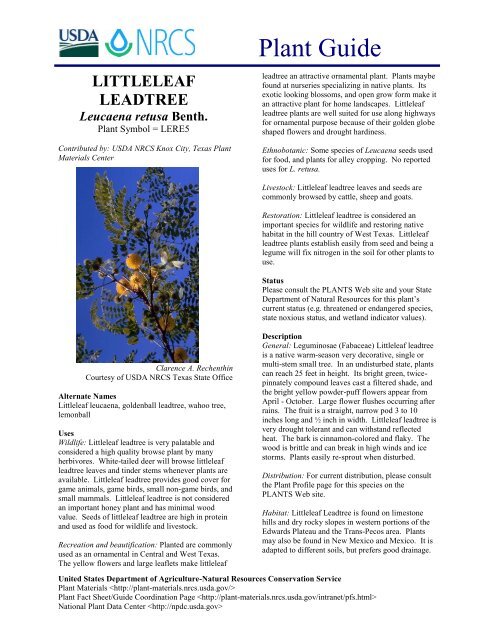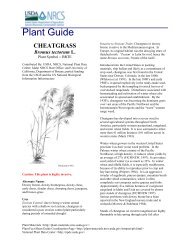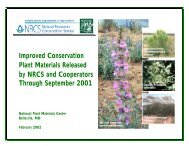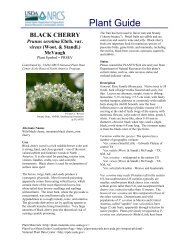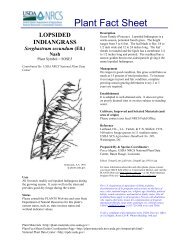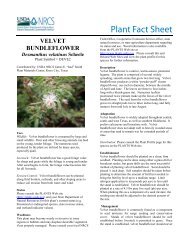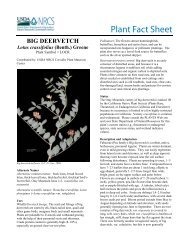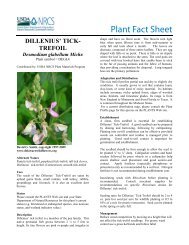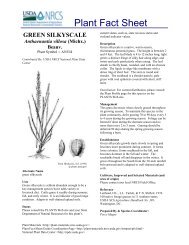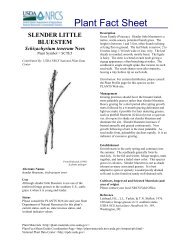Guide - USDA Plants Database - US Department of Agriculture
Guide - USDA Plants Database - US Department of Agriculture
Guide - USDA Plants Database - US Department of Agriculture
Create successful ePaper yourself
Turn your PDF publications into a flip-book with our unique Google optimized e-Paper software.
LITTLELEAF<br />
LEADTREE<br />
Leucaena retusa Benth.<br />
Plant Symbol = LERE5<br />
Contributed by: <strong><strong>US</strong>DA</strong> NRCS Knox City, Texas Plant<br />
Materials Center<br />
Clarence A. Rechenthin<br />
Courtesy <strong>of</strong> <strong><strong>US</strong>DA</strong> NRCS Texas State Office<br />
Alternate Names<br />
Littleleaf leucaena, goldenball leadtree, wahoo tree,<br />
lemonball<br />
Uses<br />
Wildlife: Littleleaf leadtree is very palatable and<br />
considered a high quality browse plant by many<br />
herbivores. White-tailed deer will browse littleleaf<br />
leadtree leaves and tinder stems whenever plants are<br />
available. Littleleaf leadtree provides good cover for<br />
game animals, game birds, small non-game birds, and<br />
small mammals. Littleleaf leadtree is not considered<br />
an important honey plant and has minimal wood<br />
value. Seeds <strong>of</strong> littleleaf leadtree are high in protein<br />
and used as food for wildlife and livestock.<br />
Recreation and beautification: Planted are commonly<br />
used as an ornamental in Central and West Texas.<br />
The yellow flowers and large leaflets make littleleaf<br />
Plant <strong>Guide</strong><br />
leadtree an attractive ornamental plant. <strong>Plants</strong> maybe<br />
found at nurseries specializing in native plants. Its<br />
exotic looking blossoms, and open grow form make it<br />
an attractive plant for home landscapes. Littleleaf<br />
leadtree plants are well suited for use along highways<br />
for ornamental purpose because <strong>of</strong> their golden globe<br />
shaped flowers and drought hardiness.<br />
Ethnobotanic: Some species <strong>of</strong> Leucaena seeds used<br />
for food, and plants for alley cropping. No reported<br />
uses for L. retusa.<br />
Livestock: Littleleaf leadtree leaves and seeds are<br />
commonly browsed by cattle, sheep and goats.<br />
Restoration: Littleleaf leadtree is considered an<br />
important species for wildlife and restoring native<br />
habitat in the hill country <strong>of</strong> West Texas. Littleleaf<br />
leadtree plants establish easily from seed and being a<br />
legume will fix nitrogen in the soil for other plants to<br />
use.<br />
Status<br />
Please consult the PLANTS Web site and your State<br />
<strong>Department</strong> <strong>of</strong> Natural Resources for this plant‟s<br />
current status (e.g. threatened or endangered species,<br />
state noxious status, and wetland indicator values).<br />
Description<br />
General: Leguminosae (Fabaceae) Littleleaf leadtree<br />
is a native warm-season very decorative, single or<br />
multi-stem small tree. In an undisturbed state, plants<br />
can reach 25 feet in height. Its bright green, twicepinnately<br />
compound leaves cast a filtered shade, and<br />
the bright yellow powder-puff flowers appear from<br />
April - October. Large flower flushes occurring after<br />
rains. The fruit is a straight, narrow pod 3 to 10<br />
inches long and ½ inch in width. Littleleaf leadtree is<br />
very drought tolerant and can withstand reflected<br />
heat. The bark is cinnamon-colored and flaky. The<br />
wood is brittle and can break in high winds and ice<br />
storms. <strong>Plants</strong> easily re-sprout when disturbed.<br />
Distribution: For current distribution, please consult<br />
the Plant Pr<strong>of</strong>ile page for this species on the<br />
PLANTS Web site.<br />
Habitat: Littleleaf Leadtree is found on limestone<br />
hills and dry rocky slopes in western portions <strong>of</strong> the<br />
Edwards Plateau and the Trans-Pecos area. <strong>Plants</strong><br />
may also be found in New Mexico and Mexico. It is<br />
adapted to different soils, but prefers good drainage.<br />
United States <strong>Department</strong> <strong>of</strong> <strong>Agriculture</strong>-Natural Resources Conservation Service<br />
Plant Materials <br />
Plant Fact Sheet/<strong>Guide</strong> Coordination Page <br />
National Plant Data Center
Adaptation<br />
The <strong><strong>US</strong>DA</strong> hardiness zones for littleleaf leadtree are<br />
7 to 9.<br />
Establishment<br />
Seed <strong>of</strong> littleleaf lead tree can be collected in late<br />
summer into fall. Collect seed pods before they split<br />
open and drop seeds. Seed <strong>of</strong> littleleaf leadtree can<br />
be planted from late winter (March) to late spring<br />
(May). Plant seeds at 1/4 to 3/4 inch deep in areas<br />
protected from browsing animals. Scarification is not<br />
necessary to improve germination, untreated seed<br />
will establish easily. Seed should also be inoculated<br />
with the correct rhizobial bacteria before planting.<br />
Fertilizer applications will improve seedling growth.<br />
Seedlings can successfully be grown in nursery pots<br />
and transplanted when needed.<br />
Management<br />
Established plants require little maintenance.<br />
Littleleaf leadtree will reseed and re-establish if<br />
young seedlings are protected from grazing animals.<br />
In areas where prescribed burning is permitted,<br />
unwanted top growth may be controlled allowing<br />
plants to re-sprout tender new growth.<br />
Seeds and Plant Production<br />
Most seed collected for production has been<br />
accomplished by hand picking from native trees.<br />
Attempts to mechanically harvest seed have not been<br />
successful. Seed production fields can be established<br />
by planting littleleaf leadtree plants in a 10 X 10 foot<br />
block. Being a legume that fixes nitrogen littleleaf<br />
leadtree plants only needs one small application <strong>of</strong><br />
phosphorous applied in the spring each year. Seeds<br />
are ready for harvest in late summer. Harvested<br />
seeds need to be dried for one to two days and treated<br />
with some type <strong>of</strong> insecticide before storage. Seed<br />
will remain viable for at least two years if stored in a<br />
cool dry place.<br />
Cultivars, Improved, and Selected Materials (and<br />
area <strong>of</strong> origin)<br />
„Yellow Puff‟ littleleaf leadtree a cultivar release<br />
from the <strong><strong>US</strong>DA</strong>-NRCS Knox City Plant Materials<br />
Center in TX, selected for use as a leguminous shrub<br />
or small tree for revegetation <strong>of</strong> critical areas, as a<br />
wildlife food plant, and as a plant for beautification.<br />
Contact your local Natural Resources Conservation<br />
Service <strong>of</strong>fice for more information. Look in the<br />
phone book under ”United States Government.” The<br />
Natural Resources Conservation Service will be<br />
listed under the subheading “<strong>Department</strong> <strong>of</strong><br />
<strong>Agriculture</strong>.”<br />
References<br />
Cox, P. W. and P. Leslie. 1988. Texas trees. Corona<br />
Publ. Co., San Antonio. 374 pp.<br />
Elias, T. S. 1980. The complete trees <strong>of</strong> North<br />
America field guide and natural history. Times<br />
Mirror Magazine, Inc., New York, New York.<br />
Englert, J. M. et al. 1999–. <strong><strong>US</strong>DA</strong>-NRCS Improved<br />
conservation plant materials released by NRCS and<br />
cooperators. (NRCS Cons Pl Mat)<br />
Hatch, S. L., K. N. Gandhi, and L. E. Brown. 1991.<br />
Checklist <strong>of</strong> the vascular plants <strong>of</strong> Texas. Texas<br />
Agric. Exp. Sta. MP-1655 College Station. 158 pp.<br />
Kingsberry, J. M. 1964. Poisonous plants <strong>of</strong> the<br />
United States and Canada. Prentice-Hall, Inc.,<br />
Englewood Cliffs, N.J. 626 pp.<br />
Native American Ethnobotany <strong>Database</strong><br />
(http://herb.umd.umich.edu, 13 June 2006).<br />
University <strong>of</strong> Michigan - Dearborn.<br />
Native plant database (http://www.wildflower2.<br />
org/NPIN/<strong>Plants</strong>/plant. html, 13 June 2006). Lady<br />
Bird Johnson Wildflower Center, Austin.<br />
Nokes, J. 1986. How to grow native plants <strong>of</strong> Texas<br />
and the Southwest. Texas Monthly Press, Inc. Austin.<br />
404 pp<br />
Pellett, F. C. 1976. American Honey <strong>Plants</strong>, 5th ed.<br />
Dadant and Sons, Hamilton, Ill.<br />
Simpson, B. J. 1988. A field guide to Texas trees.<br />
Texas Monthly Press Austin, Texas.<br />
Van Dersal, W. R. 1938. Native woody plants <strong>of</strong> the<br />
United States: their erosion-control and wildlife<br />
values. U.S. Dep. Agric. Misc. Publ. No. 303,<br />
Washington, D.C. 362 pp.<br />
Vines, R. A. 1960. Trees, shrubs and woody vines <strong>of</strong><br />
the southwest. Univ. <strong>of</strong> Texas Press, Austin. 1104 pp.<br />
Native Plant Information Network. 2001.<br />
<strong><strong>US</strong>DA</strong>, ARS, National Genetic Resources Program.<br />
Germplasm Resources Information Network -<br />
(GRIN) [Online <strong>Database</strong>]. National Germplasm<br />
Resources Laboratory, Beltsville, Maryland.<br />
URL: http://www.ars-grin.gov/cgibin/npgs/html/taxon.pl<br />
(13 March 2006).<br />
<strong><strong>US</strong>DA</strong>, NRCS 2006. The PLANTS database.<br />
(http://plants.usda.gov). National Plant Data Center,
Baton Rouge, LA 70874-4490 <strong>US</strong>A. Accessed: 13<br />
March 2006.<br />
Prepared By and Species Coordinator<br />
Morris J Houck<br />
<strong><strong>US</strong>DA</strong> NRCS Plant Materials Center, Knox City,<br />
Texas<br />
Edited: 20jun06 jsp<br />
For more information about this and other plants, please contact<br />
your local NRCS field <strong>of</strong>fice or Conservation District, and visit the<br />
PLANTS Web site or the Plant Materials<br />
Program Web site <br />
The U.S. <strong>Department</strong> <strong>of</strong> <strong>Agriculture</strong> (<strong><strong>US</strong>DA</strong>) prohibits<br />
discrimination in all its programs and activities on the basis <strong>of</strong><br />
race, color, national origin, sex, religion, age, disability, political<br />
beliefs, sexual orientation, and marital or family status. (Not all<br />
prohibited bases apply to all programs.) Persons with disabilities<br />
who require alternative means for communication <strong>of</strong> program<br />
information (Braille, large print, audiotape, etc.) should contact<br />
<strong><strong>US</strong>DA</strong>'s TARGET Center at 202-720-2600 (voice and TDD).<br />
To file a complaint <strong>of</strong> discrimination write <strong><strong>US</strong>DA</strong>, Director, Office<br />
<strong>of</strong> Civil Rights, Room 326-W, Whitten Building, 14th and<br />
Independence Avenue, SW, Washington, DC 20250-9410 or call<br />
202-720-5964 (voice or TDD). <strong><strong>US</strong>DA</strong> is an equal opportunity<br />
provider and employer.<br />
Read about Civil Rights at the Natural Resources Conservation<br />
Service.


